Website SEO audits are a staple for most SEOs - but often we put a lot of time and resource into them, without getting the end results they deserve.
Sometimes, we need to remind ourselves what’s really important, and why we actually do SEO audits. That’s what I set out to do in this guide. I then delve into how we should be approaching our audits, to get the most out of them.
I’ll look at how to plan your audit, where to focus your efforts, how to actually carry out audits, and how to add more value for clients.
A lot of focus is given to the specifics of what should be included in audits, but it’s often your overall approach that really makes a difference when it comes to getting real results.
Table of contents:
Why does your approach matter?
Most of us have been there: you’re a fresh faced SEO, maybe you’ve just started at an agency, or just had work signed off by your first client. Either way, you’re faced with the daunting reality of being tasked with ‘doing an SEO audit’. Looking back, this might seem like a pretty standard everyday task, but when you’ve never done it before it’s hard to know where to start, never mind what to include and how to deliver it!
At the opposite end of the scale; when you’ve been doing audits for years, it’s easy to slip into a comfortable routine using the same old processes.
Whichever stage of your ‘auditing life’ you’re at, it’s good to take a step back occasionally and question everything. Why do we do audits? What’s really important? How do we deliver the most value from the resources we have at our disposal? This might seem like a ‘nice’ fluffy idea to start getting all self reflective, but you’ve got work to do and money to make, “so what’s really the point?”. In a nutshell: to make your work more efficient and increase the value of your time.
If you focus on what really matters, spend more time on the stuff that makes a difference, and less on the stuff that doesn’t, the more efficient your auditing is. The more efficient you are, the less of your time and resource it takes to make the same amount of money. At the same time, if your audits provide more value, and get better results for clients, that means happy clients. Happy clients mean more work and more clients, and potentially even charging higher rates.
Throughout the article I’ll refer to ‘the client’. As an agency or consultant this may be a client in the traditional sense, but for in-house SEOs the client may be an internal team, your manager, or even yourself. In short, when I say ‘client’, I’m referring to whoever the audit is being carried out for.
We should all be striving to do better work. It feels good to know you’ve done a good job and to have pride in your work. But I’m not going to make this out to be some kind of selfless task. Doing better SEO audits is all about making money and making your life easier.
At this point I should give the caveat that this is my take on audits. As with most things, there’s no right or wrong approach to doing SEO audits. But I’d argue that some are better than others, and I’d like to hope that mine is somewhere at the better end of the scale.
What’s the purpose of a website SEO audit?
It seems like an obvious thing to say, but before any work is started, or before it’s even agreed to, everyone involved needs to be very clear what you’re trying to achieve by carrying out an audit.
“Without goals, and plans to reach them,
you are like a ship that has set sail with no destination.”
Fitzhugh Dodson
Clients often commission an audit simply because they’ve been told that’s what they need. It might well be the case that it is something they need, but not understanding why or what the end goal is, can be a recipe for misaligned expectations. An audit has the potential to get great results, but it’s not the magic bullet for all business problems, so anyone expecting that is going to be sorely disappointed even if you deliver an amazing one.
Equally, it’s easy for SEO practitioners to lapse into a routine of ‘going through the motions’ with audits. This is especially true when there’s a buffer between them and clients such as an account manager or sales team. If your end goal is simply to deliver an audit report, then you’ve lost sight of what really matters, and I’d like to bet that it’s also become a thankless task.
There’s no such thing as a perfectly optimized website, and even if there were, it would be a pretty unrealistic expectation. So if aiming for SEO perfection is unrealistic, what should we be aiming for with our audits?
The simplified answer I settled on is this:
Increase performance in the SERPs,
both in the short-term and future,
by as much as possible within the resource available.
Let’s break that down...
‘Increasing performance in the SERPs...’ (Search Engine Result Pages) is fairly self-evident. This could mean improving rankings, achieving new rankings, increasing click through rates, or less obvious things like triggering rich results.
‘...both in the short-term and future...’ may seem like an odd addition, but I feel this is needed. To make recommendations that would get results now but come with a high risk of a penalty in 6 months time would be short sighted. Equally, only giving recommendations which may get results in years to come is unlikely to address the client’s immediate needs. As always, a considered balance is needed based on the individual business.
Last but not least, we have ‘...as much as possible within the resource available.’. Understanding and maximizing the resource available is essential. Too many audit recommendations go unimplemented because there’s no-one to do them. I’m not claiming that an SEO can be held responsible for this, but if they’re aware of this lack of resource beforehand then efforts can be focused elsewhere, where there is resource available (we’ll cover this in more detail in the section on prioritization).
So we’ve considered the bigger picture of what we’re trying to achieve, but how do we actually get there? As with other types of SEO audit (such as a content audit or backlink audit), the main aim when carrying out a website SEO audit is to identify two things:
Issues which may be having detrimental effects on a website’s performance in the search engines (or have potential to do so in the future).
Opportunities to improve a website’s performance in the search engines.
Once these issues and opportunities have been identified, the audit then needs to go on to produce prioritised, actionable recommendations to address them. ‘Actionable’ is the key word here (we’ll come onto prioritization later), vague recommendations rarely get things done, the next step for any given recommendation should be clear, even if that next step involves further investigation.
Go beyond the symptoms
A common trait of poor audits is that they tend to focus on symptoms rather than digging deeper to identify the true cause of the issues.
It’s relatively easy to identify symptoms using tools and automated systems, but the reports they produce rarely go beyond these symptoms and a prompt to “fix them”. Some advanced tools may go a step further and attempt to diagnose the cause of the issues and even offer some suggestions on how to fix them, but in most cases the variables are so vast that it’s difficult to automate.

On the surface this may seem like a problem for SEOs, but the reality is that it’s this very reason that most of us are still in business. If all SEO problems could be diagnosed and fixed with a tool at the push of a button, we’d all be out of work. Instead, this is where we can add real value through experience, intuition, problem solving and creativity.
________________
Example:
A crawler identifies 10,000 duplicate URLs on a website. This in itself is a symptom. We know it’s an issue, but what we don’t know is why it’s happening.
At this stage we could simply give a list of the URLs with a recommendation for them to be canonicalized or removed.
But what we should do is dig deeper to discover what’s causing the URLs to be generated. We may discover that it’s a common issue with a particular CMS plugin being used, and can subsequently give specific instructions on how to avoid it happening again.
Neither recommendation is wrong, but the second version certainly provides more value to the client.
________________
Structuring your audit
There’s two key areas you need to consider the structure of:
Doing the audit - This is how you structure your approach to carrying out the audit. Or in other words, the process you’ll follow to guide you from start to finish. We’ll cover this in more detail in the next section.
Reporting - Secondly, you need to consider how your audit reporting should be structured to best convey the results. You might assume that reporting would simply reflect the structure that was used to carry out the audit, and that might indeed be the case, but it doesn’t need to be.
When you’re doing the audit there will be dependencies between tasks and some issues might supersede others. Whereas reporting should focus more on how best to group findings and recommendations for them to be communicated and acted upon.
There’s no reason that you need to follow the same structure for both carrying out the audit and reporting. Following only one structure for both is likely to require compromise, whereas uncoupling the two areas allows for the most appropriate approach to be taken for both.
Segmentation
Segmentation is a useful alternative to treating the website as a whole when auditing. With larger websites you can use this technique to break the site down into manageable groups of pages, but the benefits go much deeper than that.
The most obvious way to segment a website would be to break it down into sections like blog, shop, support and resources. This is a good start, but for powerful segmentation we need to consider the underlying differences between pages, and that usually means templates. When developing websites, rather than starting from scratch each time a new page is required, they’re usually based on a page template which pre-defines the design, layout and other elements.

If we were to take an ecommerce website as an example, the templates would typically include:
Homepage
Product
Category
Blog post
The reason that this is important to us when auditing, is that many of the issues and opportunities we’re looking for will be template related, and they become much more manageable when we understand that.
________________
Example:
Crawling a website might uncover that page titles are missing on 5k pages. It would be easy to give the client a list of these 5k URLs that all need their page titles populating.

But if our segmentation showed that these 5k pages 'problem pages' were all 'Product' pages, this might imply that there is a template issue to investigate. Dealing with a single template based issue becomes a whole lot easier than 5k individual page level ones.
In turn, the recommendation becomes much clearer to the client: "There is an issue with the product page template, which is not populating page titles. Get your developer to fix the issue on this template, and it should resolve all 5k identified issues."
Recommendations like this are also much more likely to get implemented. A single template fix sounds much more achievable than a daunting five thousand pages!
I should caveat that this won’t always be the case, issues aren’t always that straight forward, but working in a segmented way helps us to understand them better.
________________
When it comes to reporting, grouping recommendations by page template segments type can also be helpful for the client.
When structuring reports primarily by categories of issues (e.g. page elements, internal linking and canonicalization), recommendations for a particular page template might be spread throughout the documentation. Whereas in a segment led structure they’re grouped together to help facilitate their implementation workflow.
Below is an example of how the same audit can be structured in two different ways within reports:
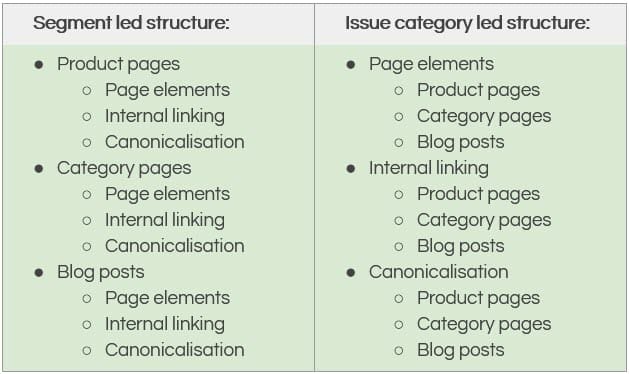
Of course there are some issues which relate to the site as a whole rather than just specific segments, so even if you’re structuring reports based on segmentation you will also need to include a section for sitewide issues.
There are also some categories of issues which might need to be addressed at both a segment and sitewide level. For instance, there may be a canonicalization issue which only affects URLs of product pages, but then an additional canonicalization issue which affects all URLs.
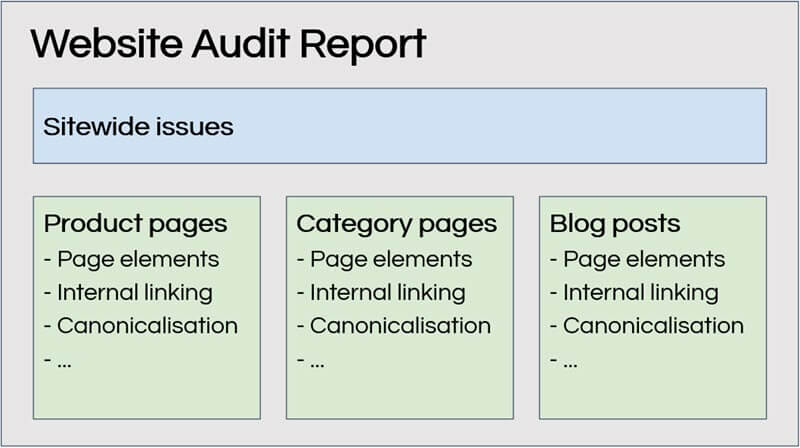
The audit process
As we covered in the previous section, you should have a structure for carrying out your audit. Your process will map out your journey through that structure, guiding you through all the steps required from start to finish.
Without a process, you have no set starting point and risk taking a scattergun approach to carrying out checks and finding issues. You might fall into a flow and naturally progress from one area to another, or you may find yourself sitting wondering “what next?”. Either way, how do you know when you’ve covered everything you need to?
You could of course create a plan from scratch for every audit you do. This would address the problems we’ve just mentioned, but it’s time consuming and still requires you to come up with the contents for the plan each time.
Having a process provides a middle ground. It gives a framework from which you can base your auditing plan and can be reused time and time again each time you need to carry out an audit. Assuming you’ve got a robust process, it’ll ensure you don’t forget to include areas of work, or waste time unsure of what to look at next.
One of the main reasons that I’ve not provided any type of process template is that the process that works for me, probably wouldn’t be ideal for you. We all work in different ways, have different needs and are in different situations.
Have a look in the resources section at the end for some help on putting together your own auditing process. But for now, we’ll look at some of the wider questions around processes.
What’s the difference between a checklist and process?
To fully appreciate the value of processes, we need to address this common confusion between a checklist and process.
If we start by looking at definitions, the main difference is that a checklist is a ‘thing’, whereas a process is an action or something you do. But for the sake of simplicity, let's assume we’re talking about a documented process, so it too becomes a ‘thing’.
A checklist is simply a list of things you need to do or check. A process can also be a list of things you need to do or check, but it comes with the added elements of order and logic. A process will have defined start and end points, with a flow (or order) mapped throughout.
A simple process might not differ much from a checklist, other than the requirement for the list of tasks to be carried out in a specific order. But a more advanced process can begin to use logic dependent upon the outcome of those tasks to direct the flow. This allows tasks or whole areas of work to be bypassed or included if and when appropriate.
For example, if there is a task to check if a robots.txt file is in place, and this check reveals that there isn’t one, then all other checks regarding robots.txt are redundant and can be bypassed. This might seem like quite an obvious example, but when you start building up lots of dependencies, many of which are much more subtle, a well documented process can mean significant efficiencies.
They’re both useful in their own ways, but processes are a much more powerful and versatile tool.
What does an SEO audit process look like?
I’ve already talked a lot about what they are, which is all very well, but you might still be wondering what form process documentation should actually take.
For a simple process, a document might suffice. But in most cases, spreadsheets are more appropriate as they allow a lot more structure. As with most things, there is of course software that can help. Personally I’ve never encountered anyone using specialist process management software for SEO audits, but I’m sure someone must be. What I have experienced plenty of is using project management software for this purpose. With most of these types of software you can create project templates containing tasks, groups and dependencies; all very useful when it comes to processes. This also has the added benefit of integrating with your wider project management.
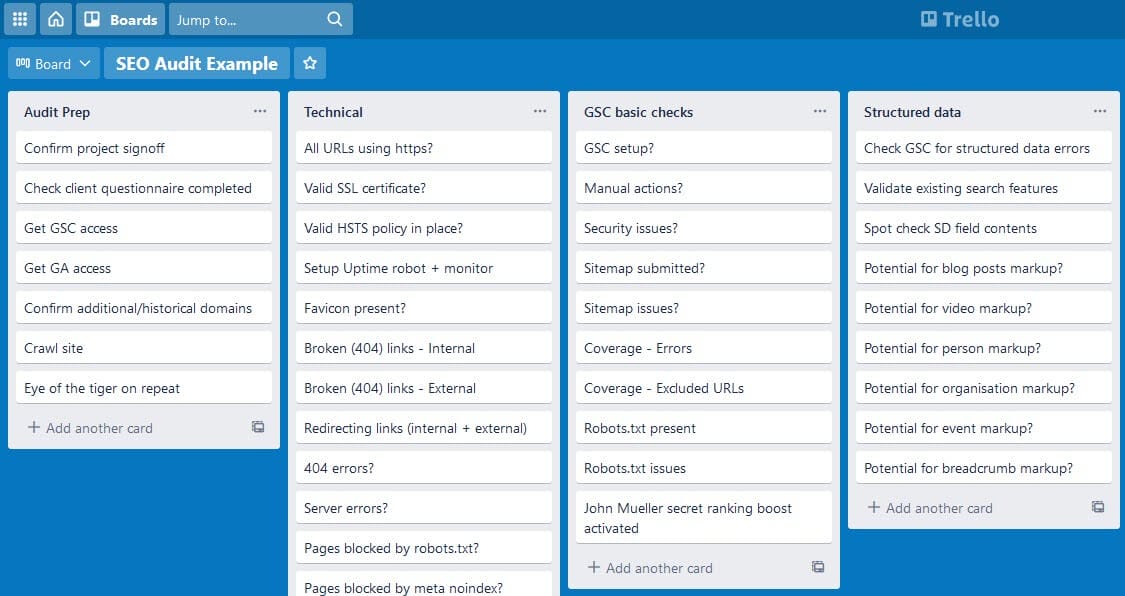
Some of the best processes use a combination of different tools. The most comprehensive SEO process setups I’ve worked with used a combination of Google Docs, Google Sheets and Teamwork (project management tool). At this point I need to give a hat tip to Mark Nunney for introducing me to some pretty epic scale process documentation when I worked with him many years ago. I’m confident in saying that our processes played a big role in being able to achieve massive SEO results in competitive markets for some household brands.
Should I use an audit checklist?
My short answer to whether you should use an SEO checklist is: yes, you probably should. It’s not quite that straightforward though. Checklists can be a really useful way to make sure you haven't missed anything. Without one, there’s always a risk that we forget to check something important. So from this perspective, they’re great.
However, an audit shouldn’t just be a matter of blindly working through a checklist of things. Two audits are rarely ever the same. What might be really important for one, could be completely irrelevant for another. So we cannot simply apply a standard checklist checklist to every scenario.
A checklist should be treated as a way to ensure we don’t forget any of the common, important things. But it should always be considered a backup - it’s likely that there will always be things that fall outside of your standard checklist, and also things within it that aren’t always relevant.
Website SEO auditing tools
When people set out to do an audit, often the first thing they consider is “Which website audit tool should I use?”.
I carried out some keyword research around SEO audits - the top search theme was around auditing tools. It might seem a logical place to start, and if doing an audit was as simple as running a tool and following a checklist, then our work would be easy. Unfortunately, it isn’t quite that simple. That’s not to say that they both don’t have their place, but you need to know how to use them.
We built Sitebulb with the understanding that the data is made to be consumed and interpreted by an SEO professional. Yes, we help people identify issues & opportunities, and guide them in investigating them further, but this is only part of the journey. SEO is nuanced, and involves many variables (including external factors) - it needs the knowledge, experience, and problem solving of an SEO professional.
Let me reiterate something I’ve already said several times - you can not, and should not, rely solely on a tool for this type of audit. Maybe sometime in the future we’ll reach the point where SEO tools are able to do this, but for now they should be treated as something to facilitate the work of an SEO professional (which some do better than others) . Basically that means that you’re going to have to use your brain - that’s what you’re paid for!
As a bare minimum you’re going to need a website crawler tool, spreadsheet and something to create your reports in. Personally I use Google Sheets/Docs for the latter two parts, but that’s largely up to personal preference. With this simple toolset, alongside a few other tools for specific checks, you should be able to carry out most of what you need to in an audit. However, as I said, this is the bare minimum. With that in mind I should give the caveat that when using a basic toolset, you’ll be required to do the ‘heavy lifting’ yourself. A crawler will get you the data, but then you’ll need to get it into a usable format to interpret, which usually means a lot of work in spreadsheets.
That’s where the next level of tools come in. Specialist auditing tools (like Sitebulb) help to process the data, present it in a usable format and carry out some of the analysis for you. They don’t do all the work, but they can make your life a lot easier. Unless you’re working to very tight budgets, this is the type of tool you should be using for your audits.
Prioritization
It could be tempting to approach an audit with grand expectations of finding and fixing each and every issue on the website and taking every opportunity for optimization.
Aside from the point that we’ve already mentioned about there being no such thing as a ‘perfect website’, we also need to consider that there will be a point of diminishing returns when deciding which actions to take forward. In other words, for some actions the resource required to implement will outweigh the benefit gained.
It’s sometimes easy to forget that an audit is often just the first step, and that the bulk of the work may lie in the implementation of recommendations once the audit has been delivered. Even if you’re not personally going to be involved in implementation, it’s essential to consider who is and any constraints they may have, including time, skills and resources.
You also need to assess what will actually make a difference. There’s no point diving straight into advanced optimization if the basics aren’t in place. If a page can’t be indexed by Google, then all of the on-page optimization in the world isn’t going to make it rank any better!
‘Mozlow’s hierarchy of SEO needs’ provides a pretty good illustration of what I’m talking about here. Essentially, if a page isn’t getting crawled/indexed, there’s no point spending time with the icing on the cake like structured data!
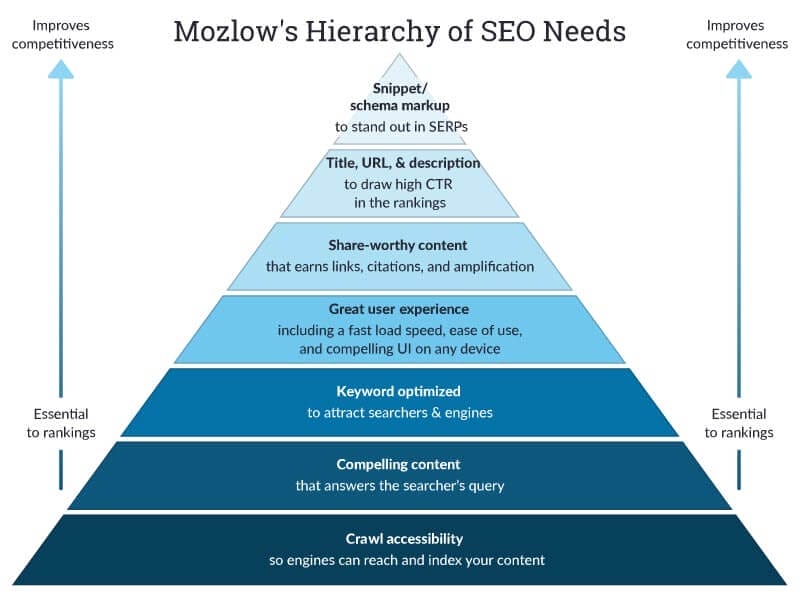
As always, there’s more than one way to approach this stuff though. Barry Adams makes a strong argument for prioritizing backwards. Assuming that you have pages at varied levels of performance, Barry recommends focusing on any with ranking issues, rather than those struggling to be crawled or indexed. This type of approach prioritizes getting results from low hanging fruit, rather than spending time on areas which will likely take much more work.
The framework for your priorities shouldn’t remain static either. Google is constantly changing its priorities, which is reflected in the weighting of its ranking factors. A significant part of an SEOs job is to interpret Google’s priorities (no easy task), and reflect them in the prioritization of their own recommendations.
Layers of considerations
There’s several layers of factors that need to be considered when prioritizing recommendations:
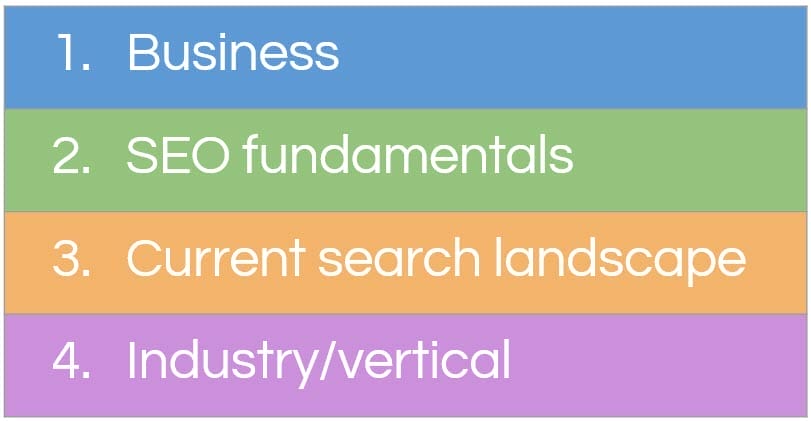
Client/Business - Each client’s situation and needs are different and this has to be taken into account. If you know that your client makes the most profit from a certain category of products, then it makes sense to focus on that part of the website. Equally, if you know there’s limited resources for producing content, there’s little point recommending hundreds of new pages as a top priority.
SEO fundamentals - As per the SEO hierarchy of needs we’ve already looked at, some things are essential for all websites.
Current search landscape - Although the fundamentals remain largely the same, Google does regularly change the goalpost for ranking well. A general understanding of Google’s current priorities is important here.
Industry/vertical - The criteria to perform well in search for different industries can differ greatly. For example, for finance and ecommerce websites some security issues can have a big impact. Whereas those same issues may be of lesser importance for a publisher type website.
It’s debatable exactly what order the layers should be in. I’d argue that the client’s needs should trump everything, as that’s essentially the whole purpose of our work. But beyond that, the most important thing is simply that you consider each of the layers in your prioritization.
Essentially the priorities you assign to the recommendations you give should help your client focus on implementing what gets best results.
Sub-audits
Throughout this article I’ve talked about website SEO audits as a whole, assuming that you want to look at all the areas which they encompass. A completely different approach however, could be to instead address individual areas in their own audits. Remember that there are no rules as to what can or can’t be included in an audit.
If resources are tight and a priority area has already been established (e.g. you know that your structured data implementation is a mess), an audit of this specific area could be a sensible option - in this case, a structured data audit.
The same can be applied with a particular area of the site (or ‘segment‘ as previously discussed). Taking this approach you might want to focus only on the ecommerce or blog sections of a site. It’s important to remember though that individual parts of the website don’t work in isolation where SEO is concerned. Although this approach can be useful for managing work, it does not replace the need for a thorough understanding of SEO issues at a website level.
If you want to read more about different types of audits, and how they fit together, have a look at my overview to SEO audits.
Conclusion
The biggest danger with SEO audits is spending valuable resources (e.g. your time!) on stuff that either never gets implemented, or just doesn't have any impact on the KPIs that matter.
Don't do things just because that's what's expected in SEO audits - focus on the things that will actually get results.
Spending time up-front planning and preparing for your audit can make for a much more efficient use of your time, and produce recommendations that actually get results. Don’t be afraid to go your own way, but do so with a considered approach.
Use tools, processes and checklists, but never do-so blindly. Ensure that your data is solid and that you know what it’s telling you. Manually check findings, especially when you’re making significant recommendations on the back of them.
Further reading & resources
SEO Audits - What they are and how to get started
by Geoff Kennedy (Me!)
If you’re looking for a wider overview of SEO audits, and how they fit into the SEO landscape, this is a good place to start.
Website SEO Audits are just one of the many types of SEO audit out there - I give a breakdown of some of the most common ones, and address practical topics like costs and time.
How to Develop Actionable and Impactful SEO Audits: The SP2 Principles
by Aleyda Solis
Aleyda dives into full detail of her SP2 audit model, focusing on four of the key areas you’ve already heard me talk about:
Strategic
Prioritized
Solutions focused
Proactive
Her in-depth guide even includes gdoc templates for you to replicate the model for your own audits.
What Is the MECE Principle?
by Benjamin Estes
MECE stands for mutually exclusive, comprehensively exhaustive - it’s another framework that can be applied to complex tasks such as audits.As well as giving an overview of the principles behind the framework, Benjamin gives a useful, example spreadsheet showing how it can be applied to SEO audits.
How to do a technical SEO audit
by Barry Adams
I mentioned Barry’s backward prioritisation model earlier, but it’s worth having a watch of his full talk from Cambridge SEO Meetup where he covers some of the processes he uses when doing an SEO audit.
Let's Never Talk About SEO Audits Again
by Tom Critchlow
Don’t let the title put you off - this is actually really useful stuff from Tom. He takes a critical look at SEO audits and how they’re often confused with strategy. He makes the case for focusing more on storytelling to drive compelling arguments for getting things implemented.
Rethinking Technical SEO Audits
by Andrew Charlton
Andrew looks at many of the same issues as I have in this piece, but takes a slightly different approach to improving the efficiency of audits and getting things implemented.
Getting Tech SEO Implemented
by Areej AbuAli
Getting stuff implemented is something most SEOs struggle with. Areej looks at some models to help get more technical SEO recommendations implemented.

Geoff is a digital marketing & SEO Consultant with over 15 years of experience working with clients around the globe. A long-time friend of Sitebulb, Geoff has even spent some time as part of the team, which clearly explains why he loves (or hates?) doing SEO audits.
Articles for every stage in your SEO journey. Jump on board.
Related Articles
 Auditing Core Web Vitals with Chrome DevTools MCP
Auditing Core Web Vitals with Chrome DevTools MCP
 AI-Driven SEO: How to Audit Your Visibility & Stop Stressing About ChatGPT
AI-Driven SEO: How to Audit Your Visibility & Stop Stressing About ChatGPT
 Webinar! The AI Search Toolkit: Audit Tactics, Tools & Techniques
Webinar! The AI Search Toolkit: Audit Tactics, Tools & Techniques
 Sitebulb Desktop
Sitebulb Desktop
Find, fix and communicate technical issues with easy visuals, in-depth insights, & prioritized recommendations across 300+ SEO issues.
- Ideal for SEO professionals, consultants & marketing agencies.
Try our fully featured 14 day trial. No credit card required.
Try Sitebulb for free Sitebulb Cloud
Sitebulb Cloud
Get all the capability of Sitebulb Desktop, accessible via your web browser. Crawl at scale without project, crawl credit, or machine limits.
- Perfect for collaboration, remote teams & extreme scale.
If you’re using another cloud crawler, you will definitely save money with Sitebulb.
Explore Sitebulb Cloud
 Geoff Kennedy
Geoff Kennedy

